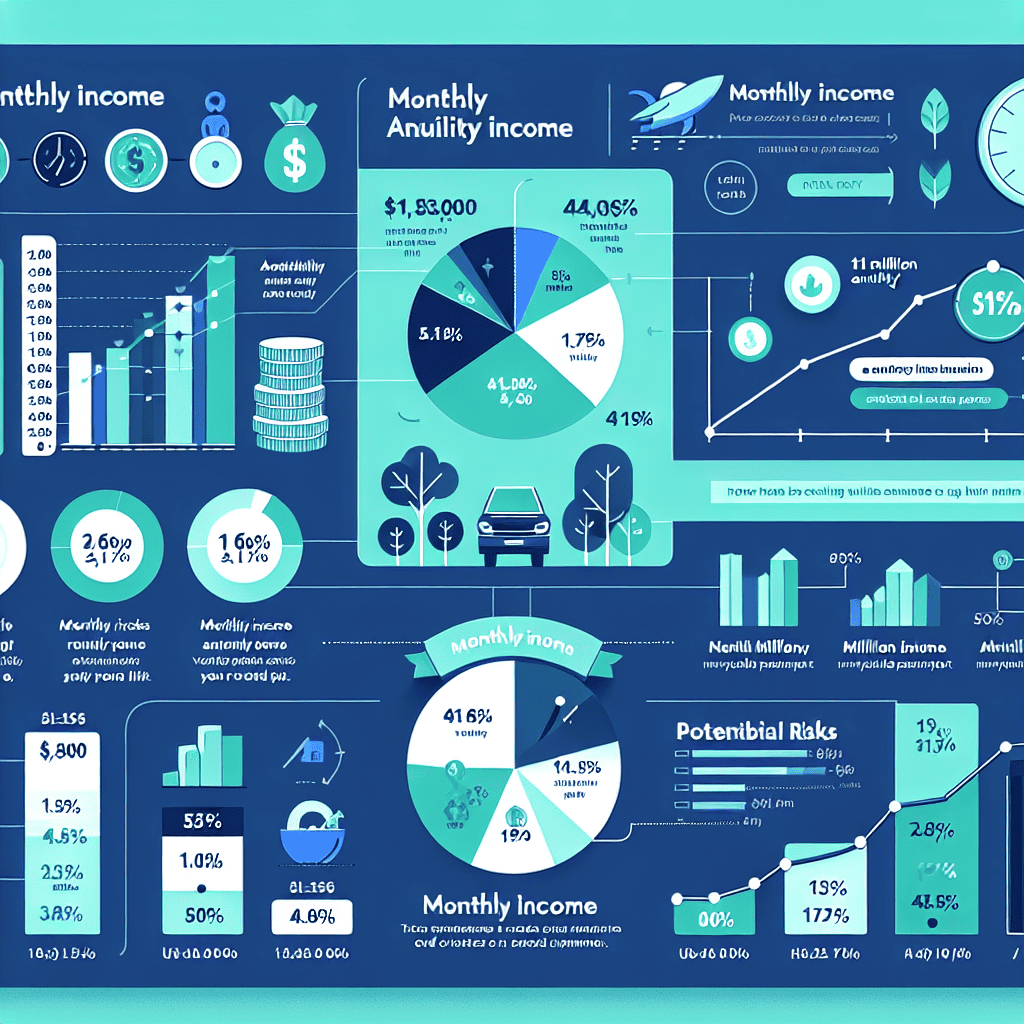“Unlock Steady Streams: Discover Your Monthly Income from a $1 Million Annuity”
Introduction
A $1 million annuity can serve as a significant source of income, providing financial stability and peace of mind during retirement. Understanding the potential monthly income from such an investment is crucial for effective financial planning. An annuity is a financial product that offers regular payments in exchange for an initial lump sum investment, and the amount you receive each month depends on various factors, including the type of annuity, interest rates, and the duration of the payout period. Whether you opt for a fixed, variable, or indexed annuity, each comes with its own set of benefits and considerations. By exploring these options, you can better anticipate the monthly income you might expect from a $1 million annuity, helping you make informed decisions to secure your financial future.
Understanding Annuities: A Beginner’s Guide
Annuities are financial products that provide a steady income stream, often used as a tool for retirement planning. Understanding how they work is crucial for anyone considering them as part of their financial strategy. When contemplating the potential monthly income from a $1 million annuity, several factors come into play, including the type of annuity, interest rates, and the duration of the payout period. These elements collectively determine the amount one can expect to receive each month.
To begin with, it is essential to understand the different types of annuities available. The two primary categories are fixed and variable annuities. A fixed annuity guarantees a specific payment amount, providing a sense of security and predictability. In contrast, a variable annuity’s payments fluctuate based on the performance of the underlying investments, offering the potential for higher returns but also carrying more risk. For those seeking a stable monthly income, a fixed annuity might be more appealing, whereas individuals willing to embrace some risk for potentially greater rewards might opt for a variable annuity.
Interest rates play a pivotal role in determining the monthly income from an annuity. Generally, higher interest rates result in higher monthly payments. However, interest rates are influenced by broader economic conditions and can vary significantly over time. When purchasing an annuity, the prevailing interest rate environment will impact the income generated. Therefore, it is advisable to consider the timing of the purchase and consult with a financial advisor to understand how current rates might affect long-term income.
The duration of the payout period is another critical factor. Annuities can be structured to provide income for a specific number of years or for the lifetime of the annuitant. Opting for a lifetime payout ensures that the individual will receive payments for as long as they live, which can be particularly beneficial for those concerned about outliving their savings. However, choosing a fixed-term payout might result in higher monthly payments, as the total amount is distributed over a shorter period. Balancing the need for immediate income with long-term financial security is a key consideration when selecting the payout duration.
Moreover, the inclusion of additional features, such as inflation protection or a death benefit, can influence the monthly income from an annuity. Inflation protection ensures that payments increase over time to maintain purchasing power, which can be crucial in a long-term financial plan. However, this feature may reduce the initial monthly payment amount. Similarly, a death benefit guarantees that beneficiaries receive a portion of the annuity’s value upon the annuitant’s death, providing peace of mind but potentially lowering monthly income.
In conclusion, the monthly income from a $1 million annuity depends on various factors, including the type of annuity, interest rates, payout duration, and additional features. Each of these elements must be carefully considered to align with individual financial goals and risk tolerance. By understanding these components, individuals can make informed decisions about incorporating annuities into their financial plans, ensuring a reliable income stream that meets their needs both now and in the future. Consulting with a financial advisor can provide valuable insights and help tailor an annuity strategy that best suits one’s unique circumstances.
Calculating Monthly Income from a $1 Million Annuity
When considering the potential monthly income from a $1 million annuity, it is essential to understand the various factors that influence the payout. An annuity, fundamentally, is a financial product that provides a steady income stream, typically used for retirement purposes. The amount of monthly income one can expect from a $1 million annuity depends on several key variables, including the type of annuity, the interest rate environment, the duration of the payout period, and any additional features or riders that may be included.
To begin with, the type of annuity selected plays a crucial role in determining the monthly income. There are primarily two types of annuities: fixed and variable. A fixed annuity guarantees a specific payout amount, providing a predictable income stream. In contrast, a variable annuity’s payouts fluctuate based on the performance of the underlying investments. Consequently, a fixed annuity might offer more stability, while a variable annuity could potentially yield higher returns, albeit with increased risk.
Moreover, the interest rate environment at the time of purchase significantly impacts the annuity’s payout. In a low-interest-rate environment, the income generated from a $1 million annuity may be lower compared to periods of higher interest rates. This is because the insurance company managing the annuity invests the principal amount to generate returns, which are then used to fund the payouts. Therefore, prevailing interest rates directly affect the investment returns and, subsequently, the monthly income.
Additionally, the duration of the payout period is another critical factor. Annuities can be structured to provide income for a specific number of years or for the lifetime of the annuitant. Opting for a lifetime annuity ensures that the individual receives payments for as long as they live, which can be particularly beneficial for those concerned about outliving their savings. However, this option may result in lower monthly payments compared to a fixed-term annuity, where the payout period is predetermined.
Furthermore, the inclusion of additional features or riders can also influence the monthly income from an annuity. For instance, a cost-of-living adjustment rider can increase payouts over time to keep pace with inflation, but this may reduce the initial monthly income. Similarly, a joint and survivor annuity, which continues payments to a spouse after the annuitant’s death, typically offers lower monthly payments than a single-life annuity.
In light of these considerations, it is challenging to provide a precise figure for the monthly income from a $1 million annuity without specific details. However, as a general guideline, a fixed annuity might offer monthly payments ranging from $4,000 to $6,000, assuming a lifetime payout and current interest rates. Variable annuities, on the other hand, could provide higher or lower amounts depending on market performance.
Ultimately, when calculating the monthly income from a $1 million annuity, it is imperative to carefully evaluate personal financial goals, risk tolerance, and the need for income stability. Consulting with a financial advisor can provide valuable insights and help tailor an annuity strategy that aligns with individual circumstances. By understanding the various factors at play, individuals can make informed decisions and optimize their retirement income strategy.
Fixed vs. Variable Annuities: Which Is Right for You?
When considering the potential monthly income from a $1 million annuity, it is crucial to understand the differences between fixed and variable annuities, as these distinctions significantly impact the income you can expect. Annuities are financial products designed to provide a steady income stream, often used as a retirement planning tool. The choice between a fixed and a variable annuity depends on your financial goals, risk tolerance, and the level of income stability you desire.
Fixed annuities offer a predictable income stream, as they provide a guaranteed payout over a specified period or for the lifetime of the annuitant. This predictability is appealing to those who prioritize stability and want to avoid the uncertainties associated with market fluctuations. With a fixed annuity, the insurance company assumes the investment risk, ensuring that the annuitant receives a consistent monthly payment. For instance, if you invest $1 million in a fixed annuity, you might receive a monthly income of approximately $4,000 to $6,000, depending on factors such as interest rates, the length of the payout period, and the age of the annuitant at the time of purchase. This steady income can be particularly beneficial for retirees who rely on a fixed budget and prefer to avoid the volatility of the stock market.
In contrast, variable annuities offer the potential for higher returns, as they are linked to the performance of underlying investment portfolios, often comprising stocks, bonds, or mutual funds. While this means that the monthly income from a variable annuity can fluctuate, it also provides the opportunity for growth, which can be advantageous in times of favorable market conditions. However, it is important to note that with this potential for higher returns comes increased risk. The value of a variable annuity can decrease if the investments perform poorly, leading to a reduction in monthly income. For those with a higher risk tolerance and a longer investment horizon, a variable annuity might be an attractive option, as it allows for participation in market gains while still offering some level of income security.
When deciding between a fixed and a variable annuity, it is essential to consider your individual financial situation and retirement goals. If you prioritize stability and predictability, a fixed annuity may be more suitable. On the other hand, if you are willing to accept some level of risk in exchange for the possibility of higher returns, a variable annuity could be the right choice. Additionally, it is worth considering a hybrid approach, such as a fixed indexed annuity, which combines elements of both fixed and variable annuities. This type of annuity offers a guaranteed minimum return while also allowing for potential growth based on the performance of a specific market index.
Ultimately, the decision between a fixed and a variable annuity should be made in consultation with a financial advisor, who can provide personalized guidance based on your unique circumstances. By carefully evaluating your risk tolerance, income needs, and long-term financial objectives, you can make an informed choice that aligns with your retirement planning strategy. Whether you opt for the stability of a fixed annuity or the growth potential of a variable annuity, understanding these options will help you maximize the benefits of your $1 million investment and secure a comfortable financial future.
Tax Implications of Annuity Income

When considering the financial benefits of a $1 million annuity, it is crucial to understand the tax implications associated with the income it generates. Annuities, often chosen for their ability to provide a steady stream of income during retirement, come with specific tax responsibilities that can significantly impact the net income received by the annuitant. Therefore, a comprehensive understanding of these tax implications is essential for effective financial planning.
To begin with, the taxation of annuity income largely depends on the type of annuity purchased. Annuities can be classified as either qualified or non-qualified, each with distinct tax treatments. Qualified annuities are funded with pre-tax dollars, typically through retirement accounts like 401(k)s or IRAs. Consequently, the entire distribution from a qualified annuity is subject to ordinary income tax upon withdrawal. This means that if you receive monthly payments from a $1 million qualified annuity, the entire amount of each payment will be taxed at your current income tax rate.
In contrast, non-qualified annuities are funded with after-tax dollars. As a result, only the earnings portion of the annuity payments is taxable. The principal amount, which was initially invested, is not subject to taxation again. The IRS uses an exclusion ratio to determine the taxable and non-taxable portions of each payment. This ratio helps annuitants understand how much of their monthly income will be taxed, allowing for more precise financial planning.
Moreover, it is important to consider the impact of the annuitant’s tax bracket on the overall tax liability. Annuity income is added to other sources of income, potentially pushing the annuitant into a higher tax bracket. This can result in a higher marginal tax rate, thereby increasing the overall tax burden. Therefore, it is advisable to consult with a tax professional to explore strategies that might mitigate this impact, such as timing withdrawals to coincide with years of lower income.
Additionally, state taxes can further influence the net income from an annuity. While some states do not tax annuity income, others may impose state income taxes, which can vary significantly. Understanding the specific tax laws in your state of residence is crucial to accurately estimating the after-tax income from your annuity.
Furthermore, it is essential to be aware of potential penalties associated with early withdrawals. If the annuitant is under the age of 59½, withdrawals from a qualified annuity may be subject to a 10% early withdrawal penalty in addition to ordinary income taxes. This penalty can substantially reduce the net income received, making it important to plan withdrawals carefully.
In conclusion, while a $1 million annuity can provide a reliable source of monthly income, the tax implications are a critical factor that must be considered. By understanding the differences between qualified and non-qualified annuities, the impact of tax brackets, state taxes, and potential penalties, annuitants can make informed decisions that maximize their after-tax income. Engaging with a financial advisor or tax professional can provide valuable insights and strategies to navigate the complexities of annuity taxation, ensuring that the financial benefits of the annuity are fully realized.
Inflation and Its Impact on Annuity Payments
When considering the financial security provided by a $1 million annuity, it is crucial to understand how inflation can impact the purchasing power of the monthly payments. An annuity, by design, offers a steady stream of income, often seen as a reliable financial tool for retirees seeking stability. However, the fixed nature of many annuity payments can become a double-edged sword in the face of inflation, which gradually erodes the value of money over time. To fully grasp the implications of inflation on annuity payments, one must first appreciate the nature of inflation itself.
Inflation is the rate at which the general level of prices for goods and services rises, subsequently eroding purchasing power. When inflation is high, each dollar buys fewer goods and services, which can significantly impact those relying on fixed incomes. For instance, if an annuity pays out $50,000 annually, this amount may suffice for a comfortable lifestyle today. However, if inflation averages 3% per year, the real value of that $50,000 will decrease over time, making it more challenging to maintain the same standard of living in the future.
To mitigate the effects of inflation, some annuities offer inflation protection features, such as cost-of-living adjustments (COLAs). These adjustments increase the annuity payments periodically, often in line with the Consumer Price Index (CPI), to help maintain the purchasing power of the income stream. While this feature can provide a buffer against inflation, it typically comes at a cost. Annuities with COLAs generally offer lower initial payments compared to those without, as the insurance company assumes additional risk by guaranteeing future payment increases.
Another strategy to combat inflation is to diversify income sources. By supplementing annuity payments with other investments that have the potential to outpace inflation, such as stocks or real estate, individuals can create a more balanced financial plan. This approach not only provides a hedge against inflation but also offers the potential for capital appreciation, which can further enhance financial security over time.
Moreover, understanding the economic environment and inflation trends can aid in making informed decisions about annuity purchases. During periods of low inflation, the impact on fixed annuity payments may be minimal, allowing retirees to enjoy a relatively stable standard of living. However, in times of rising inflation, the erosion of purchasing power can be more pronounced, necessitating a reevaluation of financial strategies.
In conclusion, while a $1 million annuity can provide a substantial and reliable income stream, it is essential to consider the impact of inflation on its long-term value. By exploring options such as inflation-protected annuities, diversifying income sources, and staying informed about economic trends, individuals can better safeguard their financial future. Ultimately, a comprehensive understanding of inflation and its effects on annuity payments will enable retirees to make more informed decisions, ensuring that their financial resources remain robust and resilient in the face of economic changes.
Comparing Annuities with Other Investment Options
When considering the potential monthly income from a $1 million annuity, it is essential to compare this option with other investment avenues to make an informed decision. Annuities, often seen as a reliable source of steady income, are financial products that provide regular payments in exchange for an initial lump sum investment. They are particularly appealing to retirees seeking a predictable income stream. However, understanding how annuities stack up against other investment options is crucial for anyone looking to maximize their financial security.
To begin with, annuities offer a unique advantage in terms of stability. Unlike stocks or mutual funds, which are subject to market volatility, annuities provide a fixed income that is not directly affected by market fluctuations. This stability can be particularly reassuring for individuals who prioritize financial certainty over potential growth. For instance, a fixed annuity might offer a guaranteed monthly payment, allowing investors to plan their expenses with confidence. However, this stability often comes at the cost of lower returns compared to more aggressive investment strategies.
In contrast, investing in stocks or mutual funds can potentially yield higher returns, albeit with increased risk. The stock market has historically provided substantial growth over the long term, making it an attractive option for those willing to endure short-term volatility. A diversified portfolio of stocks and bonds might outperform an annuity in terms of overall returns, but it requires careful management and a tolerance for risk. Moreover, the income generated from such investments can be unpredictable, fluctuating with market conditions.
Another investment option to consider is real estate. Real estate investments can offer both income and appreciation, providing a dual benefit. Rental properties, for example, can generate a steady stream of income while also appreciating in value over time. However, real estate requires active management and can be affected by market conditions, location, and property-specific factors. Additionally, the initial investment and ongoing maintenance costs can be significant, making it less accessible for some investors.
Bonds, on the other hand, present a more conservative investment choice. They offer fixed interest payments and are generally considered safer than stocks. However, the returns on bonds are typically lower, and they may not keep pace with inflation over the long term. This makes them a less attractive option for those seeking substantial income growth.
When comparing annuities with these investment options, it is important to consider individual financial goals, risk tolerance, and time horizon. Annuities may be ideal for those who prioritize a guaranteed income and are less concerned with maximizing returns. Conversely, individuals with a higher risk tolerance and a longer investment horizon might prefer the potential growth offered by stocks or real estate.
In conclusion, while a $1 million annuity can provide a stable and predictable monthly income, it is essential to weigh this against other investment options. Each investment type has its own set of advantages and disadvantages, and the best choice depends on personal financial objectives and circumstances. By carefully evaluating these factors, investors can make a well-informed decision that aligns with their long-term financial goals.
Strategies for Maximizing Annuity Income
When considering the potential monthly income from a $1 million annuity, it is essential to explore strategies that can maximize this income while ensuring financial stability. An annuity, by definition, is a financial product that provides a steady stream of income, typically used as a retirement strategy. The amount of income one can expect from a $1 million annuity depends on several factors, including the type of annuity chosen, the interest rates at the time of purchase, and the payout options selected. Understanding these elements is crucial for making informed decisions that align with one’s financial goals.
To begin with, the type of annuity plays a significant role in determining the monthly income. Fixed annuities offer a guaranteed payout, providing a sense of security with predictable income. In contrast, variable annuities fluctuate based on the performance of underlying investments, potentially offering higher returns but with increased risk. Indexed annuities, which are tied to a stock market index, offer a middle ground, combining elements of both fixed and variable annuities. Each type has its advantages and drawbacks, and the choice largely depends on the individual’s risk tolerance and financial objectives.
Moreover, interest rates at the time of annuity purchase significantly impact the income generated. Higher interest rates generally lead to higher payouts, as the insurance company can invest the principal at more favorable rates. Therefore, timing the purchase of an annuity during periods of higher interest rates can be a strategic move to maximize income. However, predicting interest rate movements can be challenging, and waiting for the perfect moment may not always be practical. Thus, it is often advisable to focus on long-term financial goals rather than short-term market conditions.
Another critical factor in maximizing annuity income is the selection of payout options. Annuities offer various payout structures, such as life-only, joint-life, and period-certain options. A life-only annuity provides income for the duration of the annuitant’s life, typically offering higher monthly payments. However, payments cease upon the annuitant’s death, leaving no benefits for heirs. Joint-life annuities, on the other hand, continue payments to a surviving spouse, albeit at a reduced rate, ensuring financial support for both partners. Period-certain annuities guarantee payments for a specified number of years, providing a balance between income security and legacy planning. Evaluating these options in the context of personal circumstances and priorities is essential for optimizing annuity income.
Furthermore, tax considerations should not be overlooked when strategizing to maximize annuity income. Annuity payments are generally subject to income tax, with the taxable portion depending on whether the annuity was purchased with pre-tax or after-tax dollars. Understanding the tax implications and exploring tax-efficient withdrawal strategies can help preserve more of the annuity income. Consulting with a financial advisor or tax professional can provide valuable insights tailored to individual situations.
In conclusion, maximizing monthly income from a $1 million annuity involves careful consideration of various factors, including the type of annuity, prevailing interest rates, payout options, and tax implications. By thoroughly evaluating these elements and aligning them with personal financial goals, individuals can make informed decisions that enhance their financial security and ensure a stable income stream throughout retirement.
Q&A
1. **What is an annuity?**
An annuity is a financial product that provides a steady stream of income, typically used for retirement purposes, in exchange for an initial lump sum payment.
2. **How does a $1 million annuity work?**
A $1 million annuity involves investing $1 million with an insurance company or financial institution, which then pays out regular income over a specified period or for the lifetime of the annuitant.
3. **What factors affect the monthly income from a $1 million annuity?**
Factors include the type of annuity (fixed, variable, or indexed), interest rates, the annuitant’s age and life expectancy, and any additional features like inflation protection or survivor benefits.
4. **What is the expected monthly income from a fixed annuity?**
A fixed annuity might provide a monthly income ranging from $4,000 to $6,000, depending on current interest rates and the terms of the annuity contract.
5. **How does a variable annuity differ in terms of monthly income?**
A variable annuity’s monthly income can fluctuate based on the performance of the underlying investments, potentially offering higher returns but with greater risk.
6. **What is the impact of choosing a lifetime annuity?**
A lifetime annuity guarantees income for the rest of the annuitant’s life, which may result in lower monthly payments compared to a fixed-term annuity, but it provides longevity protection.
7. **Are there tax implications for annuity income?**
Yes, annuity income is generally subject to income tax. The portion of the payment that represents earnings is taxable, while the portion that represents a return of principal is not.
Conclusion
A $1 million annuity can provide a steady stream of income, with the exact monthly payout depending on factors such as the type of annuity, interest rates, and the age and gender of the annuitant. For a fixed annuity, assuming a 3-5% annual return, the monthly income could range from approximately $2,500 to $4,200. Variable annuities might offer higher potential returns but come with greater risk. Immediate annuities provide guaranteed payments, while deferred annuities allow the investment to grow before payouts begin. Ultimately, the choice of annuity type and terms will significantly impact the monthly income, making it crucial to align the annuity with individual financial goals and risk tolerance.





